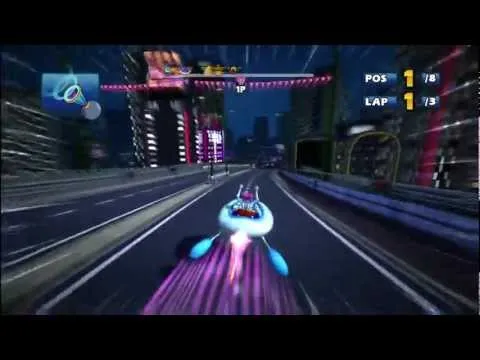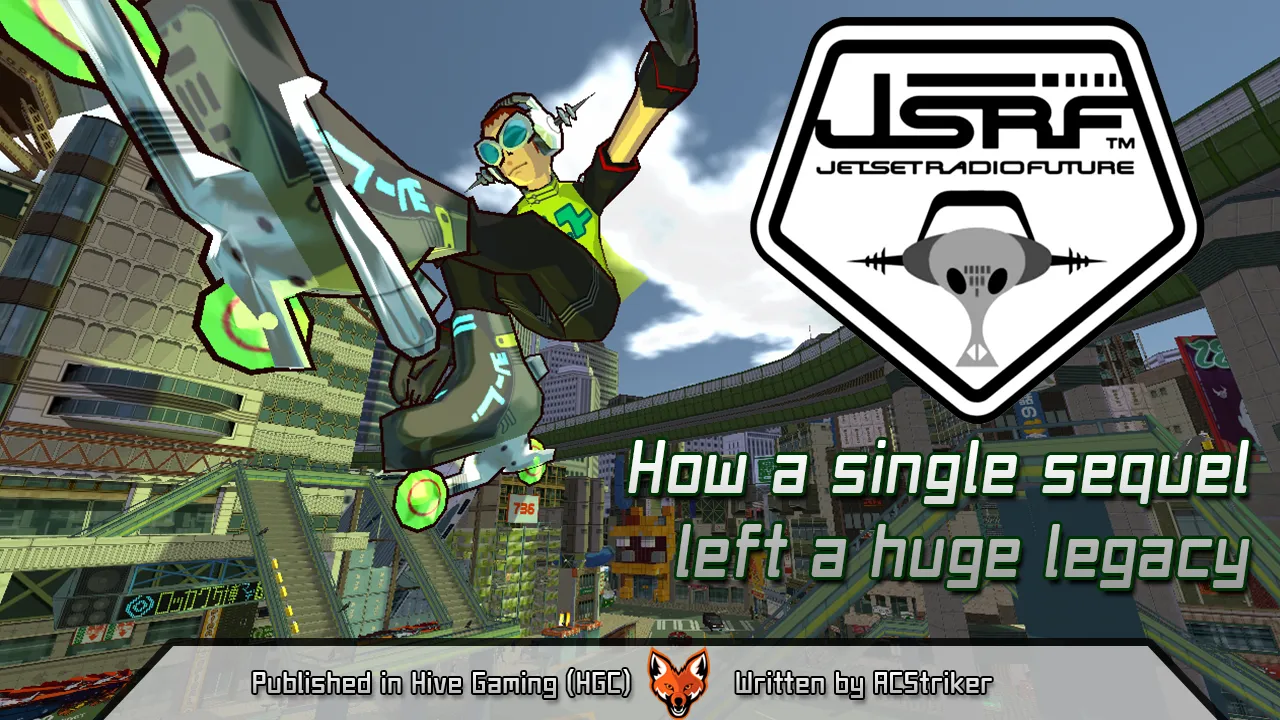
This post is avaliable in both English and Spanish.
If you want to read it in English, just scroll below. If you want to read it in Spanish, press CTRL+F and type "-ESP-" (without quotes) on the bar that shows up to get to the Spanish version immediately. Alternatively, just keep scrolling down until the end of the English section.
Este post está disponible en ambos Inglés y Español.
Si quieres leerlo en inglés, solo sigue abajo. Si quieres leerlo en español, presiona CTRL+F y escribe "-ESP-" (sin comillas) en la barra que aparece para llegar a la versión en Español inmediatamente. Alternativamente, solo sigue bajando hasta el final de la sección en Inglés.
English
The original Jet Set Radio became a cult classic on the Dreamcast despite shortcomings and the relatively quick development time thanks to the premise and style, and would be one of several titles that act as unique gems to the SEGA Dreamcast along with Shenmue and Metropolis Street Racer. However, with the PS2 huge success squashing the Dreamcast lifespan (discontinued in 2002), several of these rarer gems on Saturn and Dreamcast ended up getting sequels and ports to Microsoft Xbox of all things. One of these rare sequels exclusive on Xbox would be none other than Jet Set Radio Future.
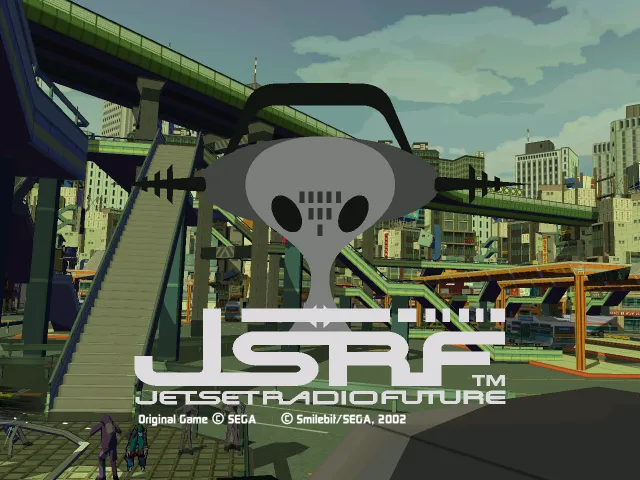
Knowing the potential on the concept and additional polish to do with the idea of a sequel, JSRF expands the premise with a larger amount of maps, and improving greatly the controls as emphasis is added to doing tricks midair and while grinding for speed (air tricks similar to Tony Hawk Pro Skater) and the addition of a boost button. In both substance and interactivity, this is a definitely a better game over the original, and it does have a tutorial from the beginning so it is impossible to miss out on the new game basics.
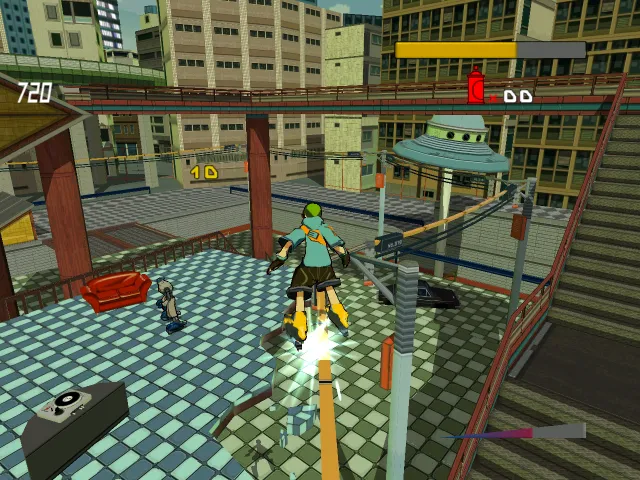
Structurally it is also quite different: Instead of selecting specific stages and missions on a map, you get a sort of open world and need to travel to other areas through certain places, giving the game an interconnected feel of a city. Most notably, there isn't a time limit anymore into exploring any places, but there's definitely more time spent in going to levels (since there's no quick travel options) and sometimes you have to revisit previously played areas.
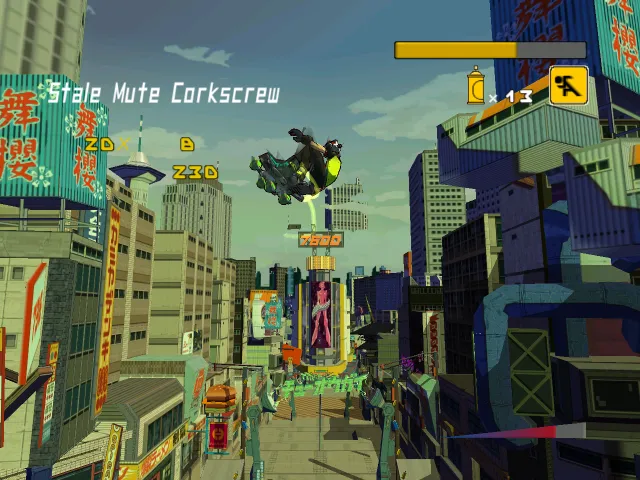
The other main draw from the original JSR was the graffiti, which you could customize and had to do commands with the stick to draw on the spots. However with the bigger worlds and faster gameplay, these small events were ditched and now you can just hold the trigger over the graffiti tag spots to do so. Larger graffiti targets will just have more spots to tag to complete it instead of doing commands. And of course, you still can find Graffiti Souls to change your graffiti at the garage.

The objectives are much more linear as you often have to arrive to a set area and tag all the graffiti targets to progress into unlocking another map and objective. Sometimes, you have to fight against police by running into them and then tagging their backs. At certain points you also have to give chase to a rival gang and tag their backs as well, just like those missions in JSR. One unique thing about JSRF is how these type of missions (graffitti tagging, tagging rivals, races, etc) are also featured in a versus mode which you can play with up to 4 players.
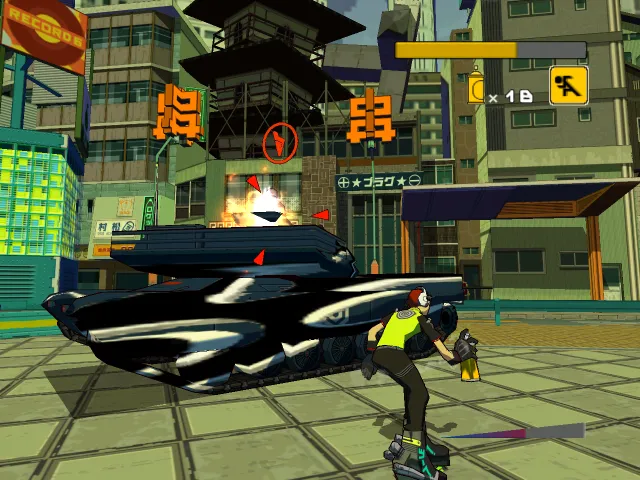
The visual presentation manages to one-up the original Jet Set Radio's cel-shaded flair with huge crowded and detailed cities with unique landmarks, and most have a lot of high places to go (like Grind Square in the original) which give some cool sights. Many stages use interesting colors over the lightning which make the character look more vibrant wherever you are.
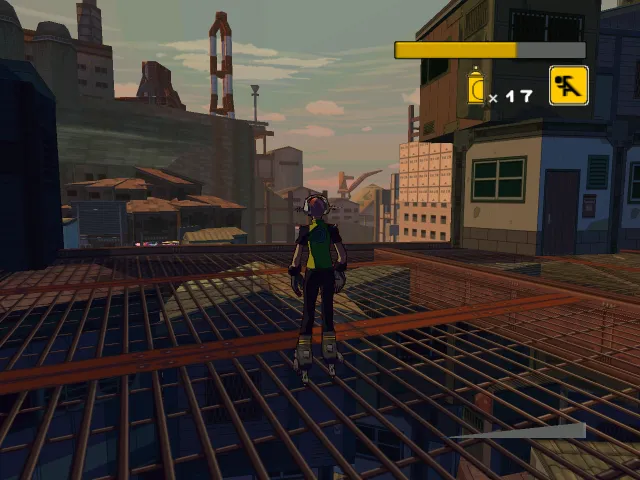
The stages itself are quite creative and still feel distinct from each other, with the starting ones having tons and tons of rails to grind. Kibogaoka Hill has you grinding right above the downtown suburbs and doing a lot of jumps, 99th Street has a huge dragon rail on the center, the Tokyo Sewage has a lot of upward climbing and half-pipes, and Sky Dinosaurian Park is basically a rollercoaster built at the top of the city...with nothing awaiting below if you fall!
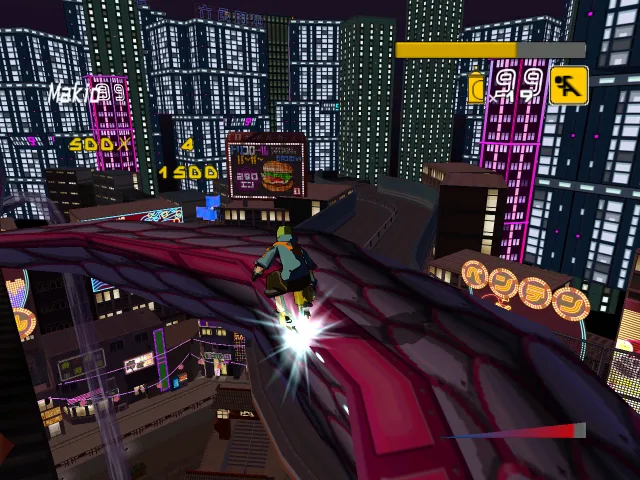
There's definitely a lot of stuff to do with the stages and missions which are waaaay more than the original, but there are also the "Street Challenges" which you can find and unlock for a stage and then complete to unlock more Graffiti Souls on the map (on top of those that already were there).
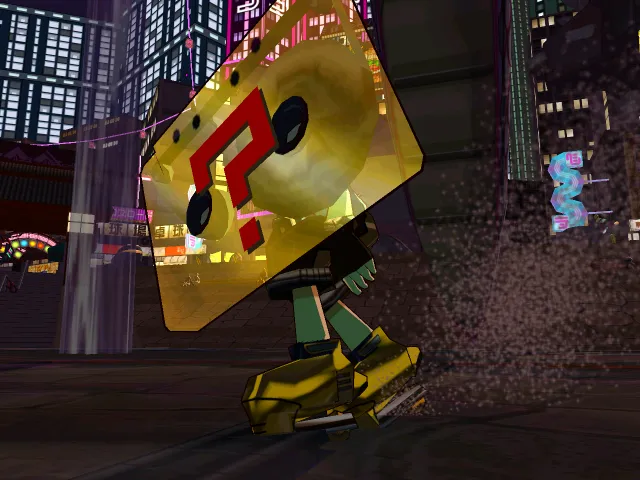
While the original Jet Set Radio is still praised by the visual style and soundtrack, Jet Set Radio Future not only one-upped everything from visual flair to the killer soundtrack with the increased power and storage from the Xbox, but also is a vastly superior game in playability and content (along with the multiplayer features), making many players remember it with much fonder memories. It also got representation in Sonic & SEGA All Stars Racing, with Beat using his JSRF design and two tracks lifted based off JSRF stages (ASR Transformed went with OG JSR designs and tracks instead).
However, something that gives JSRF its quite particular status is how it is currently stuck on the original Xbox of all places: Up to this day it has not been ported to any other consoles, and it isn't even avaliable with backward compatibility on the Xbox One X or Series X (only on X360 if you have the original disc). This has got many fans asking for years for a remake of JSRF, and as it has been 10 years already since the original got ported to new consoles, who knows if they might finally give that to us...but until then, there's still an alternative!
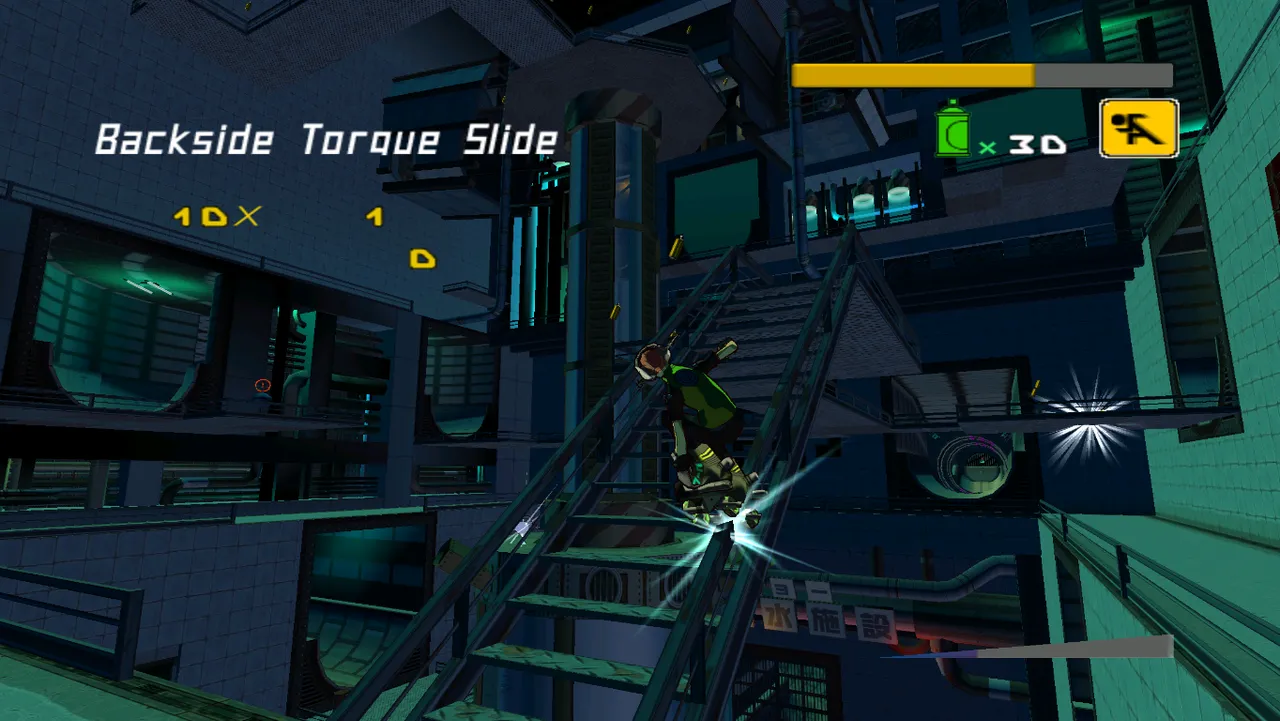
All of the screenshots I took (and my playthrough) were done with Cxbx-Reloaded, a Xbox emulator which had been doing promising progress since some few years ago. Jet Set Radio Future works wonders in here, and while the previous screenshots were taken at the native 640x480 resolution the Xbox had, it can run at higher resolutions (and as seen above, in widescreen with a patch, though it is buggy in some areas).
It is incredible in how this emulator ended up breaking JSRF's strange curse (at least to an extent) and allowing PC owners to experience this very hidden gem. I would definitely like to talk about Cxbx-Reloaded itself one day, and also there's also a fanmade remake of JSRF that is quite promising as well...but that will be for another time.
If you can check out this game, then you definitely won't be disappointed: It holds up quite amazingly thanks to the smooth controls and the visual style being so polished. While it is truly a tragedy that SEGA hasn't re-released this game yet, it is a godsend that Cxbx-Reloaded is there to allow more players to finally enjoy it.
Español -ESP-
El Jet Set Radio original se convirtió en un clásico de culto en la Dreamcast a pesar de las deficiencias y el tiempo de desarrollo relativamente rápido gracias a la premisa y el estilo, y sería uno de los varios títulos que actúan como joyas únicas de la SEGA Dreamcast junto con Shenmue y Metropolis Street Racer. Sin embargo, con el enorme éxito de la PS2 que aplastó la vida útil de la Dreamcast (descatalogada en 2002), varias de estas joyas más raras de Saturn y Dreamcast acabaron recibiendo secuelas y ports a la Xbox de Microsoft. Una de estas raras secuelas exclusivas de Xbox sería nada menos que Jet Set Radio Future.

Conociendo el potencial del concepto y el pulido adicional de la idea de una secuela, JSRF amplía la premisa con una mayor cantidad de mapas, y mejorando en gran medida los controles, ya que se añade el énfasis en hacer trucos en el aire y mientras se moldea la velocidad (trucos aéreos similares a los de Tony Hawk Pro Skater) y la adición de un botón de impulso. Tanto en sustancia como en interactividad, este es un juego definitivamente mejor que el original, y tiene un tutorial desde el principio por lo que es imposible perderse los nuevos fundamentos del juego.

Estructuralmente también es bastante diferente: en lugar de seleccionar etapas y misiones específicas en un mapa, tienes una especie de mundo abierto y necesitas viajar a otras áreas a través de ciertos lugares, lo que le da al juego una sensación interconectada de una ciudad. Lo más destacable es que ya no hay un límite de tiempo para explorar ningún lugar, pero definitivamente hay que invertir más tiempo en ir a los niveles (ya que no hay opciones de viaje rápido) y a veces hay que volver a visitar zonas ya jugadas.

El otro gran atractivo del JSR original eran los grafitis, que podías personalizar y tenías que hacer comandos con el stick para dibujar en las manchas. Sin embargo, con los mundos más grandes y una jugabilidad más rápida, estos pequeños eventos se han eliminado y ahora basta con mantener el gatillo sobre los puntos de grafiti para hacerlo. Los objetivos de grafiti más grandes solo tendrán más puntos que etiquetar para completarlos en lugar de hacer comandos. Y, por supuesto, todavía puedes encontrar almas de grafiti para cambiar tu grafiti en el garaje.

Los objetivos son mucho más lineales, ya que a menudo tienes que llegar a una zona determinada y etiquetar todos los objetivos de los grafitis para avanzar hasta desbloquear otro mapa y objetivo. A veces, tienes que luchar contra la policía corriendo hacia ellos y luego etiquetando sus espaldas. En algunos momentos también tienes que perseguir a una banda rival y marcar sus espaldas, al igual que en las misiones de JSR. Una cosa única de JSRF es que este tipo de misiones (etiquetado de grafitis, etiquetado de rivales, carreras, etc.) también aparecen en un modo versus que puedes jugar con hasta 4 jugadores.

La presentación visual consigue superar el estilo cel-shaded del Jet Set Radio original, con ciudades enormes, llenas de gente y detalladas, con puntos de referencia únicos, y la mayoría de ellas con muchos lugares altos (como Grind Square en el original) que ofrecen unas vistas geniales. Muchos escenarios utilizan interesantes colores sobre la iluminación que hacen que el personaje se vea más vibrante dondequiera que esté.

Los escenarios en sí son bastante creativos y siguen siendo distintos unos de otros, ya que los iniciales tienen toneladas y toneladas de raíles para utilizar. En Kibogaoka Hill tendrás que subir por encima de los suburbios del centro de la ciudad y realizar un montón de saltos, 99th Street tiene un enorme raíl de dragón en el centro, el alcantarillado de Tokio tiene un montón de subidas y medios tubos, y Sky Dinosaurian Park es básicamente una montaña rusa construida en lo alto de la ciudad... ¡sin que nada te espere abajo si te caes!

Definitivamente hay un montón de cosas que hacer con los escenarios y las misiones que son muuuuchas más que el original, pero también están los "Desafíos de la calle" que puedes encontrar y desbloquear para un escenario y luego completar para desbloquear más Almas de Grafiti en el mapa (además de los que ya estaban allí).

Mientras que el Jet Set Radio original sigue siendo elogiado por su estilo visual y su banda sonora, Jet Set Radio Future no solo superó todo, desde el estilo visual hasta la banda sonora asesina, con la mayor potencia y almacenamiento de la Xbox, sino que también es un juego muy superior en jugabilidad y contenido (junto con las funciones multijugador), lo que hace que muchos jugadores lo recuerden con mucho más cariño. También tuvo representación en Sonic & SEGA All Stars Racing, con Beat usando su diseño de JSRF y dos pistas levantadas en base a los escenarios de JSRF (ASR Transformed se decantó por los diseños y pistas de JSR originales).
Sin embargo, algo que le da a JSRF su estatus bastante particular es cómo está actualmente atascado en la Xbox original de todos los lugares: A día de hoy no ha sido portado a ninguna otra consola, y ni siquiera está disponible con retrocompatibilidad en la Xbox One X o Series X (solo en X360 si tienes el disco original). Esto ha hecho que muchos fans pidan durante años un remake de JSRF, y como ya han pasado 10 años desde que el original fue portado a las nuevas consolas, quién sabe si finalmente nos lo darán... pero hasta entonces, ¡todavía hay una alternativa!

Todas las capturas de pantalla que tomé (y mi playthrough) se hicieron con Cxbx-Reloaded, un emulador de Xbox que lleva haciendo prometedores progresos desde hace unos años. Jet Set Radio Future funciona de maravilla aquí, y aunque las capturas anteriores fueron tomadas a la resolución nativa de 640x480 que tenía la Xbox, puede funcionar a resoluciones más altas (y como se ve arriba, en pantalla panorámica con un parche, aunque tiene fallos en algunas zonas).
Es increíble cómo este emulador acabó rompiendo la extraña maldición de JSRF (al menos hasta cierto punto) y permitiendo a los propietarios de PC experimentar esta joya tan escondida. Definitivamente me gustaría hablar de Cxbx-Reloaded algún día, y también hay un remake de JSRF por fans que es bastante prometedor... pero eso será para otra ocasión.
Si puedes echarle un vistazo a este juego, seguro que no te decepcionará: Se mantiene de forma sorprendente gracias a la suavidad de los controles y al estilo visual tan pulido. Aunque es una verdadera tragedia que SEGA no haya reeditado aún este juego, es un regalo del cielo que Cxbx-Reloaded esté ahí para que más jugadores puedan disfrutar de él.
